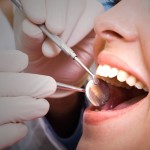
November is Mouth Cancer Awareness month here in the UK and around 6,500 cases are diagnosed a year. Mouth cancer is the 6th commonest cancer worldwide. In India, Sir Lanka and Pakistan it is the most common cancer for men and is responsible for 30% of all new cancer cases. Tobacco use, alcohol consumption, betel quid chewing and low socio-economic status are considered to be the most important risk factors of oral cancer. Mortality and morbidity from the disease is high and the incidence is increasing. While technologies for treating mouth cancer have improved five-years survival rates have remained around 50% in many countries, this is in part due to late-stage presentation.
The aim of this Cochrane review was to estimate the diagnostic accuracy of conventional oral examination (COE), vital rinsing, light-based detection, biomarkers and mouth self examination (MSE), used singly or in combination, for the early detection of potentially malignant disorders (PMD) or cancer of the lip and oral cavity in apparently healthy adults.
Medline, the Cochrane Diagnostic Test Accuracy Studies Register, the Cochrane Oral Health Group’s Trials Register, Embase, and the MEDION databases were searched without restriction. Studies that reported the diagnostic test accuracy of tests for detecting PMD or cancer of the lip or oral cavity where diagnosis was made by specialist clinicians, pathologists, or by follow-up were included.
Study screening. Eligibility data extraction and quality assessment were carried out by at least two authors independently and in duplicate. Methodological quality was assessed using the QUADAS-2 tool
- Thirteen studies, recruiting 68,362 participants, were included. 10 studies evaluated the diagnostic accuracy of COE, 2 mouth self-examination (MSE) and 1 randomised controlled of test accuracy trial directly evaluated COE and vital rinsing.
- Data could not be pooled because of clinical heterogeneity.
- For COE (10 studies, 25,568 participants), prevalence in the diagnostic test accuracy sample ranged from 1% to 51%. 3 studies were considered to be at low risk of bias, 2 at high risk and 5 at unclear risk. Sensitivity and Specificity are shown in the table.
[table id=45 /]
- Applicability was of low concern overall for two studies; high concern overall for three studies due to high-risk population, and unclear overall applicability for five studies.
The authors concluded
The prevalence of the target condition both between and within index tests varied considerably. For COE estimates of sensitivity over the range of prevalence levels varied widely. Observed estimates of specificity were more homogeneous. Index tests at a prevalence reported in the population (between 1% and 5%) were better at correctly classifying the absence of PMD or oral cavity cancer in disease-free individuals that classifying the presence in diseased individuals. Incorrectly classifying disease-free individuals as having the disease would have clinical and financial implications following inappropriate referral; incorrectly classifying individuals with the disease as disease-free will mean PMD or oral cavity cancer will only be diagnosed later when the disease will be more severe. General dental practitioners and dental care professionals should remain vigilant for signs of PMD and oral cancer whilst performing routine oral examinations in practice.
Comment
The increasing incidence of mouth cancer is a public health concern that has led to pressure to introduce screening programmes. The background and discussion sections of this review touch on some important issues related to this , including the fact that the natural history of mouth cancer is not fully understood, there is lack of agreement and limited evidence on the best management strategies for PMD, together with limited information on malignant transformation rates in PMD. All of these issues have an impact on decisions on whether to implement a screening programme. In parts of the world where dental services are well developed ( as the authors note in their conclusion) there is a clear need for practitioners to remain vigilant for signs of PMD and oral cancer whilst performing routine oral examinations in practice. I would also add that they should also be active in persuading patients to stop using tobacco and betel quid and to consume alcohol within recommended limits as these are well recognised risk factors.
Links
Walsh T, Liu JLY, Brocklehurst P, Glenny AM, Lingen M, Kerr AR, Ogden G, Warnakulasuriya S, Scully C. Clinical assessment to screen for the detection of oral cavity cancer and potentially malignant disorders in apparently healthy adults. Cochrane Database of Systematic Reviews 2013, Issue 11. Art. No.: CD010173. DOI: 10.1002/14651858.CD010173.pub2.
Brocklehurst P, Kujan O, O’Malley LA, Ogden G, Shepherd S, Glenny AM. Screening programmes for the early detection and prevention of oral cancer. Cochrane Database of Systematic Reviews 2013, Issue 11. Art. No.: CD004150. DOI: 10.1002/14651858.CD004150.pub4.
UK criteria for appraising screening programmes
Cancer Research UK – Mouth & Oropharyngeal cancer
Oral Cancer Awareness Foundation (USA)

Oral examination to detect potentially malignant disorders and mouth cancer @TheDentalElf http://t.co/Ae28w1xG4Q
[…] Dental Elf -25th Nov 2013 – Oral examination to detect potentially malignant disorders and mou… […]
[…] Oral examination to detect potentially malignant disorders and mouth cancer […]